Ginger Simpson's Blog, page 31
September 17, 2016
Filling Ginger Simpson's Shoes by Connie Vines

Ginger Simpson may be stepping down as the Queen of "Spunk, Sass, and Inspiration" here at Dishin' It Out, the blog she created; but she won't be absent. I will still be posting snippets of her writing and reposts many of her wonderfully delightful takes on her eventful life! (Remember her books are available online at Amazon.com).
Ginger has been a dear friend and mentor of mine for many years. I was so excited when I was asked to post each Thursday and to be included in "Sunday Snippets" weekly blog hop. (And I was also so fearful that I simply wouldn't measure-up.)
I know Ginger is only be an email away if I have any questions, or need assistance--because that's the kind of caring person she is!
Well Ginger, wish me luck. I have a very famous pair of cowgirl boots to fill.
Connie Vines
Here are the links to Sunday's Blog hop:
http://yesterrdayrevisitedhere.blogspot.com/http://connievines.blogspot.com/http://triciamg.blogspot.com/
Published on September 17, 2016 23:35
I'm back and gone again. I'm turning this blog over...
I'm back and gone again. I'm turning this blog over to Connie as the owner and any changes made will be up to her. She and Lynda have done an excellent job in keeping the blog alive while I went on vacation and ended up having surgery. It's been a pleasure to be welcomed by so many over the years and I will miss Dishin' It Out. Thank you so much for your support and I hope you'll continue with Connie and Lynda.
Published on September 17, 2016 08:48
September 12, 2016
Bucket List and White Knuckle Driving
Admit it. We all have bucket lists, even if we don’t want to admit we do. Some of the items on my bucket list I’m fairly certain I’ll never do because at this point there isn’t a snow ball’s chance in a very warm place of me ever getting on a plane again, so unless Superman shows up and offers to personally fly me to Scotland, Ireland, and Great Britain, I’m not going there.

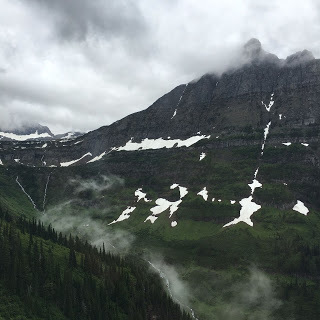
But, this summer while on vacation, I did check one item off my bucket list. The day we went to Glacier National Park was forecast as sunny in the morning, with increasing clouds by mid-morning and a one hundred percent chance of rain by afternoon. That was a pretty sure bet we were going to get rained on while in Glacier. The item on my bucket list I was hoping to check off was driving The Going to the Sun Road through Glacier. Going to the Sun Road takes ten weeks to clear in the spring, and that’s with using several heavy snow movers capable of moving 4000 tons of snow an hour.
 HOLY MOSES! Twists, turns, hairpin switch backs, waterfalls, wildlife, and by the time we’d reached Logan Pass, the clouds were socking the park in and the rain was beginning. Add several thousand feet drop-offs, sheer cliff walls on the other side of the road, shoulders to the road of no more than two or three feet and it was the most stunningly gorgeous white-knuckle drive I’ve ever undertaken. At several points during this drive, snow splattered the windshield with the rain. Yeah, I was white-knuckling it. And my respect for those people who drive those snow-movers in the early summer to open the road increased exponentially.
HOLY MOSES! Twists, turns, hairpin switch backs, waterfalls, wildlife, and by the time we’d reached Logan Pass, the clouds were socking the park in and the rain was beginning. Add several thousand feet drop-offs, sheer cliff walls on the other side of the road, shoulders to the road of no more than two or three feet and it was the most stunningly gorgeous white-knuckle drive I’ve ever undertaken. At several points during this drive, snow splattered the windshield with the rain. Yeah, I was white-knuckling it. And my respect for those people who drive those snow-movers in the early summer to open the road increased exponentially.
(Some of the pictures I’ve shared here I did not take—and I’ve tried to give credit where credit is due.)


But, this summer while on vacation, I did check one item off my bucket list. The day we went to Glacier National Park was forecast as sunny in the morning, with increasing clouds by mid-morning and a one hundred percent chance of rain by afternoon. That was a pretty sure bet we were going to get rained on while in Glacier. The item on my bucket list I was hoping to check off was driving The Going to the Sun Road through Glacier. Going to the Sun Road takes ten weeks to clear in the spring, and that’s with using several heavy snow movers capable of moving 4000 tons of snow an hour.

 HOLY MOSES! Twists, turns, hairpin switch backs, waterfalls, wildlife, and by the time we’d reached Logan Pass, the clouds were socking the park in and the rain was beginning. Add several thousand feet drop-offs, sheer cliff walls on the other side of the road, shoulders to the road of no more than two or three feet and it was the most stunningly gorgeous white-knuckle drive I’ve ever undertaken. At several points during this drive, snow splattered the windshield with the rain. Yeah, I was white-knuckling it. And my respect for those people who drive those snow-movers in the early summer to open the road increased exponentially.
HOLY MOSES! Twists, turns, hairpin switch backs, waterfalls, wildlife, and by the time we’d reached Logan Pass, the clouds were socking the park in and the rain was beginning. Add several thousand feet drop-offs, sheer cliff walls on the other side of the road, shoulders to the road of no more than two or three feet and it was the most stunningly gorgeous white-knuckle drive I’ve ever undertaken. At several points during this drive, snow splattered the windshield with the rain. Yeah, I was white-knuckling it. And my respect for those people who drive those snow-movers in the early summer to open the road increased exponentially. (Some of the pictures I’ve shared here I did not take—and I’ve tried to give credit where credit is due.)
Published on September 12, 2016 22:44
September 8, 2016
Paw Patrol by Connie Vines
I am a little late in posting today. This is because I'm on PAW Patrol.

My little Chanel, my poodle-mix, was spayed 5 days ago. She is healing quite nicely, thanks for asking. However, if you have ever taken care of an ailing child--or puppy, you know I am getting 'disturbed' sleep.
Like most novelists, I also hold a day job (in education field).
And like a care provider for any recovering puppy, I make 3 to 4 trips during the night to the great outdoors holding a squirming puppy. A puppy, mind you, that must be leashed and gingerly allowed (without getting her stitches wet/dirty) to walk in the grass of business. Then take her back to her kennel for a 'nap'.
Fortunately, my husband is able to take care of her during the day. Why Chanel only makes 4 outside tarps between 7 and 4, I do not understand. Of course, feeding time takes place during the day, but that doesn't result in sleep deprivation, to staggering around in the dark.
So it is now 8:45, Chanel is in bed, and I am happily sitting with my iPad in my lap writing this blog post and listening to an episode of Moose TV.
Happy Thursday everyone.
I will be back next week,Connie Vines

My little Chanel, my poodle-mix, was spayed 5 days ago. She is healing quite nicely, thanks for asking. However, if you have ever taken care of an ailing child--or puppy, you know I am getting 'disturbed' sleep.
Like most novelists, I also hold a day job (in education field).
And like a care provider for any recovering puppy, I make 3 to 4 trips during the night to the great outdoors holding a squirming puppy. A puppy, mind you, that must be leashed and gingerly allowed (without getting her stitches wet/dirty) to walk in the grass of business. Then take her back to her kennel for a 'nap'.
Fortunately, my husband is able to take care of her during the day. Why Chanel only makes 4 outside tarps between 7 and 4, I do not understand. Of course, feeding time takes place during the day, but that doesn't result in sleep deprivation, to staggering around in the dark.
So it is now 8:45, Chanel is in bed, and I am happily sitting with my iPad in my lap writing this blog post and listening to an episode of Moose TV.
Happy Thursday everyone.
I will be back next week,Connie Vines
Published on September 08, 2016 21:04
September 5, 2016
I Won't Forget
 Every year, September 11th rolls around. And, every year, for the past fifteen years, I stop and pause at about 8:45 in the morning and ask for forgiveness for myself for my anger, and my rage, and for the forgiveness of those who perpetuated this attack that I cannot grant. I ask for peace and comfort to be granted to the families of those who lost loved ones on that day.
Every year, September 11th rolls around. And, every year, for the past fifteen years, I stop and pause at about 8:45 in the morning and ask for forgiveness for myself for my anger, and my rage, and for the forgiveness of those who perpetuated this attack that I cannot grant. I ask for peace and comfort to be granted to the families of those who lost loved ones on that day. For the past several years, I have found myself asking what happened to our sense of righteous anger for an attack on us that targeted innocent civilians? What happened to that sense of community we shared in the aftermath of the worst attack on our soil we have ever experienced? What happened to the righteous anger that seethed within us, the need to right a wrong so grievous our nation and even most of the world came to a shuddering stop for days?
I cannot forget the events of that morning in September, 2001. I will never be able to forget the hysteria, the panic, and the absolute terror in my daughter’s voice when she called me from school, and begged me to come and get her. Her terror was real because at the time, we lived within the fallout range of a nerve-gas ‘munitions storage facility. I will never forgive the people who perpetuated the attack on our soil and made my baby girl so terrified she could barely speak to me on the phone.
I will never forget the quiet rage I saw simmering in the depths of my son’s eyes and that gave a dead, level near monotone to his voice when he announced he wanted me to sign for him to enlist in the military. He was all of seventeen. I made him promise if he still felt as he did on that day when he turned eighteen in six months, I would send him to the armed services with my complete blessing. I will never forgive the bastards who put so much anger into a young man known for his sweetness and light.
I will never forget how sick I felt watching that second plane angle into the Tower and the sound of the engines revving higher—all for maximum impact. I will never forget the tears I shed for a friend who was booked on that second plane. For three days, I cried for a lost friend. And, when my cell phone rang with his number in the caller ID, I was almost afraid to answer it. At the last minute, the business deal he was working on fell through and he had to spend another day in Boston. It took him three days to get out of Boston and get to somewhere with a cell phone signal.
I will also never forget my husband holding me the night of September 11th as I cried for the fear and rage my children suddenly knew, cried for the “hole in the world”, cried for the loss of my friend, cried because I couldn’t strike back at those who had struck us. My husband didn’t know what else to do, other than hold me, and he held me as if I would drown if he let me go. I might have drowned in my own tears. Even now, the memory of those dark and painful days for the nation I love has me writing this with tears rolling down my face.
I will never forget where I was on that beautiful fall morning when I heard we had been attacked by cowards purporting to be advocates of a religion of peace. If this and the many continued attacks against Western civilization and freedom is their idea of peace, I want nothing to do with it.

Published on September 05, 2016 22:00
August 29, 2016
Cattle Kate: fact or fiction
Just a few months before Wyoming changed status from “Territory” to “State”—the unthinkable happened. A lynch mob composed of six cattle ranchers (“barons” actually) lynched two homesteaders in the Sweetwater Valley near Independence Rock in late July of 1889. Lynching is bad enough, but the lies told by the Cheyenne newspapers—which were virtually bought and paid for by those cattle barons made things much worse for the aspersions cast upon the two homesteaders. What was even more criminal in this matter was one of those homesteaders was a woman, Ellen Watson.
 Ellen Watson
Ellen Watson
I purchased George Huffsmith’s book The Wyoming Lynching of Cattle Kate when our vacation party visited the Territorial Prison in Laramie. Huffsmith is lifelong Wyoming native and his approach to this heinous crime was part true detective writing and part prosecutorial stating of the facts. This lynching wasn’t about stolen (rustled) cattle. Huffsmith makes the compelling argument that this was about land and water rights—and water was the lifeblood of Wyoming, then as it is now. Ellen Watson was not the “loose woman” the cattlemen claimed she was, and she certainly wasn’t bartering sex for maverick calves. Watson’s husband did not run a bawdy house. And the six men who were involved in this crime never faced justice, because all of the witnesses strangely disappeared or died. (Can’t make this stuff up, because if I did, no one would believe it.)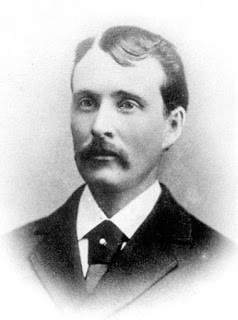 Jim Averell
Jim Averell
I started reading this book while we were camping on our property and finished it in one afternoon. With the wind whispering over the sage and scrub grasses—and often times whistling as it rose and created whirling dust-devils, I found myself transported to another time. Our small slice of Wyoming isn’t that far from the Sweetwater River valley. I could easily imagine what it must have been like to homestead this area at the turn of the previous century. And, I found myself offering up a prayer for the two murdered homesteaders.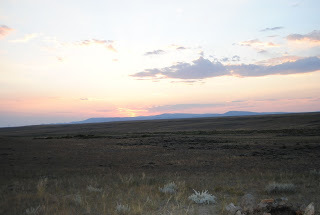 our little piece of Wyoming--the Rattlesnake Range in the distance
our little piece of Wyoming--the Rattlesnake Range in the distance
For more reading on the people involved with these murders, follow this link: http://www.wyohistory.org/essays/covering-cattle-kate
 Ellen Watson
Ellen WatsonI purchased George Huffsmith’s book The Wyoming Lynching of Cattle Kate when our vacation party visited the Territorial Prison in Laramie. Huffsmith is lifelong Wyoming native and his approach to this heinous crime was part true detective writing and part prosecutorial stating of the facts. This lynching wasn’t about stolen (rustled) cattle. Huffsmith makes the compelling argument that this was about land and water rights—and water was the lifeblood of Wyoming, then as it is now. Ellen Watson was not the “loose woman” the cattlemen claimed she was, and she certainly wasn’t bartering sex for maverick calves. Watson’s husband did not run a bawdy house. And the six men who were involved in this crime never faced justice, because all of the witnesses strangely disappeared or died. (Can’t make this stuff up, because if I did, no one would believe it.)
 Jim Averell
Jim AverellI started reading this book while we were camping on our property and finished it in one afternoon. With the wind whispering over the sage and scrub grasses—and often times whistling as it rose and created whirling dust-devils, I found myself transported to another time. Our small slice of Wyoming isn’t that far from the Sweetwater River valley. I could easily imagine what it must have been like to homestead this area at the turn of the previous century. And, I found myself offering up a prayer for the two murdered homesteaders.
 our little piece of Wyoming--the Rattlesnake Range in the distance
our little piece of Wyoming--the Rattlesnake Range in the distanceFor more reading on the people involved with these murders, follow this link: http://www.wyohistory.org/essays/covering-cattle-kate
Published on August 29, 2016 22:00
August 24, 2016
Mail-Order Brides in the Wild West By Connie Vines
MAIL-ORDER BRIDES in the Wild West.
We have all watched many a western movie featuring Mail-Order Brides. I also recall a musical
(Seven Brides for Seven Brothers) on stage before becoming a 1950's movie also.
So how historically accurate were these movies and (Here Come The Brides) television shows?
What was I able to uncover during my research?
The term "mail-order bride," as it applies to a marriage arranged via correspondence between American men and women in the Great Plains in the nineteenth century, is largely a misnomer. Twentieth-century folklore has it that a homesteader could peruse the Sears and Roebuck or Montgomery Ward catalogs and order a wife to be delivered to his dusty doorstep just as easily as he could order a rifle, stove, or stomach cure, but the truth is far more interesting.
Arranged long-distance marriage existed in the Plains in a range of communities, took a number of forms, and grew out of a variety of social, economic, and cultural phenomena, but never involved the literal sale, purchase, or ownership of women, as the term "mail-order bride" suggests. (Thank goodness!)
Among Plains Indians, sight-unseen marriage was frequently arranged with the help of a middleman and could involve the payment of a "bride price," intended to compensate the woman's family for the impending loss of her labor. But intercultural marriage was rare. In 1854, at a peace conference at Fort Laramie, a prominent Cheyenne chief requested of the U.S. Army the gift of 100 white women as brides, but the army refused. Russian immigrants brought with them the tradition of koopla, whereby marriage brokers were paid a fee to pair men with potential spouses from the Old Country.
During the peak years of overland migration, hundreds of thousands of white women traveled west, but the majority were already married, and it was thought that "suitable" single women did not go west alone. While many cowboys eschewed marriage for perpetual bachelorhood, homesteaders believed that married men made better farmers.
From the 1830s until the turn of the twentieth century, settlers pined for "that useful and essential article of household furniture–a wife." So severe was the shortage of single white women of marriageable age in Nebraska, recounts Mari Sandoz in Old Jules (1935), her classic portrait of Plains homesteading, "a man had to marry anything that got off the train."
By 1865 it was estimated that there were as many as 30,000 single women back east, a number augmented by the Civil War widows. The plenitude of bachelors in the Plains–and hence the chance for greater social and economic freedom away from home–beckoned women. Newspapers from Nebraska to Kansas and Wyoming (a state the Ladies Home Journal in 1899 declared a heaven for spinsters and widows) began to serve as forums for matchmaking, running regular "matrimonial columns" of paid advertisements, frequently with accompanying photographs, for example: "A young lady residing in one of the small towns in Central New York is desirous of opening a correspondence with some young man in the West, with a view to a matrimonial engagement. . . . she is about 24 years of age, possesses a good moral character . . . is tolerably well-educated, and thoroughly versed in the mysteries of housekeeping"; or more commonly, "A Bachelor of 40, good appearance and substantial means, wants a wife. She must be under 30, amiable, and musical." Across the Plains there arose a cottage industry of "heart and hand" catalogs, folded double sheets and broadsides devoted entirely to the matrimonial prospects.
Letters were the only means of courtship between potential mates separated by thousands of miles. According to one bride, the Pony Express "took about four weeks to go from east to west," and letters "often came in bundles." Language was a means of persuasion. Illiterate men could dictate their letters to typists who, for a fee, would doctor their sentiments on Remington Standards. Dishonesty was a risk. Men and women could easily misrepresent their physical attributes, their station, or finances. A homesteader who sent his betrothed a train ticket might find that she had turned it in for cash. A 1911 Wahpeton Times article tells of a New York girl for whom, upon arrival in Buford, North Dakota, "the spell was immediately broken" when she saw the face of her intended. ((Not unlike the social media matches of today's cyber world of romance.)
The railroad also played an important role in the western diaspora of single women. In 1882 businessman Fred Harvey sought young rural women "of good character, attractive and intelligent" as waitresses in whistlestop cafés along the Santa Fe rail line. Harvey required that they remain single for a year, live in chaperoned dormitories, and entertain callers in "courting parlors." By the turn of the century, he had married off nearly 5,000 so-called Harvey Girls.
In the 1870s, 80s and 90’S, Matrimonial News, a San Francisco based matchmaking newspaper helped to make love connections between the single men of the West and the statistically disadvantaged, single women back East. For $1.50 a word, people could place classified ads describing themselves and what they wanted in a potential mate. The paper’s goal was to “promote honorable matrimonial engagements and true conjugal felicities for amiable men and women.” If a match resulted in a wedding, both parties were required to pay an additional fee to the newspaper.
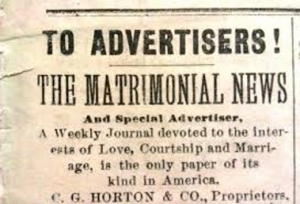
Most ads were fairly direct. I haven’t seen a single ad that mentioned enjoying long walks on the beach, but plenty of them were quite open about wanting someone who wasn’t ugly and had a specified amount of money. (At $1.50 a word, it’s a wonder that some ads didn’t read, “Me want woman!”) Interested parties would correspond with each other and often not meet until they were about to head to the altar. It was quite the leap of faith.
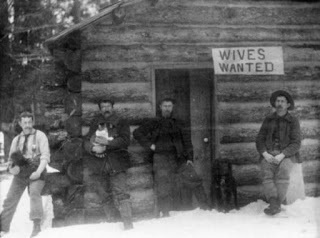
I have a feeling "Seven Brides for Seven Brothers" was not historically accurate--though a great deal of fun!
What would drive a woman to accept such a proposal? What recourse did she have if she changed her mind?
If you have any 'family stores', please share in the comments section of this blog.
Happy Reading,
Connie
Rodeo Romance, Book 2!Link to Amazon.com !
For additional information:
Luchetti, Cathy. "I Do!": Courtship, Love, and Marriage on the American Frontier: A Glimpse at America's Romantic Past through Photographs, Diaries, and Journals, 1715–1915. New York: Crown Trade Paperbacks, 1996.
Riley, Glenda. Building and Breaking Families in the American West. Albuquerque: University of New Mexico Press, 1996.
We have all watched many a western movie featuring Mail-Order Brides. I also recall a musical
(Seven Brides for Seven Brothers) on stage before becoming a 1950's movie also.
So how historically accurate were these movies and (Here Come The Brides) television shows?
What was I able to uncover during my research?
The term "mail-order bride," as it applies to a marriage arranged via correspondence between American men and women in the Great Plains in the nineteenth century, is largely a misnomer. Twentieth-century folklore has it that a homesteader could peruse the Sears and Roebuck or Montgomery Ward catalogs and order a wife to be delivered to his dusty doorstep just as easily as he could order a rifle, stove, or stomach cure, but the truth is far more interesting.
Arranged long-distance marriage existed in the Plains in a range of communities, took a number of forms, and grew out of a variety of social, economic, and cultural phenomena, but never involved the literal sale, purchase, or ownership of women, as the term "mail-order bride" suggests. (Thank goodness!)
Among Plains Indians, sight-unseen marriage was frequently arranged with the help of a middleman and could involve the payment of a "bride price," intended to compensate the woman's family for the impending loss of her labor. But intercultural marriage was rare. In 1854, at a peace conference at Fort Laramie, a prominent Cheyenne chief requested of the U.S. Army the gift of 100 white women as brides, but the army refused. Russian immigrants brought with them the tradition of koopla, whereby marriage brokers were paid a fee to pair men with potential spouses from the Old Country.
During the peak years of overland migration, hundreds of thousands of white women traveled west, but the majority were already married, and it was thought that "suitable" single women did not go west alone. While many cowboys eschewed marriage for perpetual bachelorhood, homesteaders believed that married men made better farmers.
From the 1830s until the turn of the twentieth century, settlers pined for "that useful and essential article of household furniture–a wife." So severe was the shortage of single white women of marriageable age in Nebraska, recounts Mari Sandoz in Old Jules (1935), her classic portrait of Plains homesteading, "a man had to marry anything that got off the train."
By 1865 it was estimated that there were as many as 30,000 single women back east, a number augmented by the Civil War widows. The plenitude of bachelors in the Plains–and hence the chance for greater social and economic freedom away from home–beckoned women. Newspapers from Nebraska to Kansas and Wyoming (a state the Ladies Home Journal in 1899 declared a heaven for spinsters and widows) began to serve as forums for matchmaking, running regular "matrimonial columns" of paid advertisements, frequently with accompanying photographs, for example: "A young lady residing in one of the small towns in Central New York is desirous of opening a correspondence with some young man in the West, with a view to a matrimonial engagement. . . . she is about 24 years of age, possesses a good moral character . . . is tolerably well-educated, and thoroughly versed in the mysteries of housekeeping"; or more commonly, "A Bachelor of 40, good appearance and substantial means, wants a wife. She must be under 30, amiable, and musical." Across the Plains there arose a cottage industry of "heart and hand" catalogs, folded double sheets and broadsides devoted entirely to the matrimonial prospects.
Letters were the only means of courtship between potential mates separated by thousands of miles. According to one bride, the Pony Express "took about four weeks to go from east to west," and letters "often came in bundles." Language was a means of persuasion. Illiterate men could dictate their letters to typists who, for a fee, would doctor their sentiments on Remington Standards. Dishonesty was a risk. Men and women could easily misrepresent their physical attributes, their station, or finances. A homesteader who sent his betrothed a train ticket might find that she had turned it in for cash. A 1911 Wahpeton Times article tells of a New York girl for whom, upon arrival in Buford, North Dakota, "the spell was immediately broken" when she saw the face of her intended. ((Not unlike the social media matches of today's cyber world of romance.)
The railroad also played an important role in the western diaspora of single women. In 1882 businessman Fred Harvey sought young rural women "of good character, attractive and intelligent" as waitresses in whistlestop cafés along the Santa Fe rail line. Harvey required that they remain single for a year, live in chaperoned dormitories, and entertain callers in "courting parlors." By the turn of the century, he had married off nearly 5,000 so-called Harvey Girls.
In the 1870s, 80s and 90’S, Matrimonial News, a San Francisco based matchmaking newspaper helped to make love connections between the single men of the West and the statistically disadvantaged, single women back East. For $1.50 a word, people could place classified ads describing themselves and what they wanted in a potential mate. The paper’s goal was to “promote honorable matrimonial engagements and true conjugal felicities for amiable men and women.” If a match resulted in a wedding, both parties were required to pay an additional fee to the newspaper.

Most ads were fairly direct. I haven’t seen a single ad that mentioned enjoying long walks on the beach, but plenty of them were quite open about wanting someone who wasn’t ugly and had a specified amount of money. (At $1.50 a word, it’s a wonder that some ads didn’t read, “Me want woman!”) Interested parties would correspond with each other and often not meet until they were about to head to the altar. It was quite the leap of faith.

I have a feeling "Seven Brides for Seven Brothers" was not historically accurate--though a great deal of fun!
What would drive a woman to accept such a proposal? What recourse did she have if she changed her mind?
If you have any 'family stores', please share in the comments section of this blog.
Happy Reading,
Connie
Rodeo Romance, Book 2!Link to Amazon.com !
For additional information:
Luchetti, Cathy. "I Do!": Courtship, Love, and Marriage on the American Frontier: A Glimpse at America's Romantic Past through Photographs, Diaries, and Journals, 1715–1915. New York: Crown Trade Paperbacks, 1996.
Riley, Glenda. Building and Breaking Families in the American West. Albuquerque: University of New Mexico Press, 1996.
Published on August 24, 2016 22:01
August 17, 2016
Cowboy Lingo by Connie Vines
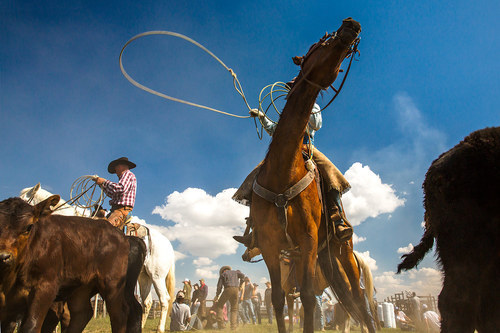 When it comes to vocabulary, you could say the cowboy tends to have a rather colorful one. However, I've listed a few words he has retired (or perhaps never used much in the first place).1. Lasso:This is a word that was used in the early days of cattle ranching, but fell out of favor fairly early on. Unlike many cowboy words that originated from Spanish descent, this one came from the Portuguese word, “laco,” meaning “to snare.” With the exception of a few California stockmen who continued to use it, the word “lasso” was replaced with “rope” within a few short years of its introduction around the late 1800s to early 1900s. This fact makes the popularity of “lasso” among city slickers, especially journalists, in this day and age even more baffling. Bottom line, a rope is a rope. Acceptable variations include “lariat,” “lass rope” and “twine,” but never “lasso.”2. Bucking Bronco: Another word that originated in the late 1800’s was “bronco,” derived from the Spanish word “potro bronco” meaning “untamed colt.” The “o” was quickly dropped and “bronc” is the word still used today. If you go to a rodeo, you will see two “bronc” riding events, bareback bronc riding and saddle bronc riding. However, if you hear just “bronc riding,” this is normally a reference to “saddle bronc riding,” whereas bareback bronc riding is simply known as “bareback riding.” Likewise, saddle bronc riders are referred to as “bronc riders” and bareback riders are known as such. Just forget “bucking,”drop the “o” from bronco.
When it comes to vocabulary, you could say the cowboy tends to have a rather colorful one. However, I've listed a few words he has retired (or perhaps never used much in the first place).1. Lasso:This is a word that was used in the early days of cattle ranching, but fell out of favor fairly early on. Unlike many cowboy words that originated from Spanish descent, this one came from the Portuguese word, “laco,” meaning “to snare.” With the exception of a few California stockmen who continued to use it, the word “lasso” was replaced with “rope” within a few short years of its introduction around the late 1800s to early 1900s. This fact makes the popularity of “lasso” among city slickers, especially journalists, in this day and age even more baffling. Bottom line, a rope is a rope. Acceptable variations include “lariat,” “lass rope” and “twine,” but never “lasso.”2. Bucking Bronco: Another word that originated in the late 1800’s was “bronco,” derived from the Spanish word “potro bronco” meaning “untamed colt.” The “o” was quickly dropped and “bronc” is the word still used today. If you go to a rodeo, you will see two “bronc” riding events, bareback bronc riding and saddle bronc riding. However, if you hear just “bronc riding,” this is normally a reference to “saddle bronc riding,” whereas bareback bronc riding is simply known as “bareback riding.” Likewise, saddle bronc riders are referred to as “bronc riders” and bareback riders are known as such. Just forget “bucking,”drop the “o” from bronco.
3. Chaps: This one is a little confusing. Most cowboy newbies pronounce the word “ch-aps” like “chapstick.” This is improper pronunciation of the word. It is actually pronounced “sh-aps.” As in, “Chantilly”. And the short, knee or shin length chaps cowboys wear? Well, those are called “chinks,” pronounced exactly like you think it would be. 4. Cowboy Up: Cowboys aren’t really much for following the crowd. If they were, they would be far less mysterious and cool. So, you may still hear this phrase tossed around occasionally, but likely more as a catchy story headline than a jolt of encouragement behind the bucking chutes.

5. Giddy-Up:I looked this up in Webster’s online dictionary and it is actually a word, spelled giddyap. Meaning: to go ahead or go faster. Now, I have been around cowboys my whole entire life and I have never (not once) heard a cowboy say “giddy-up.” Although I am not sure what the precise origin of the word is, I have heard speculation that it may come from the draft horse driving command “gee up,” which means “go faster.” The only person I recall ever using is a parent sitting a toddler on a rocking horse.For more cowboy speak, catch Pro-Rodeo interviews on ESPN.Or, download one of my Rodeo Romance novels!What Woman Does Love a Cowboy? Click to link to Amazon.com!

Published on August 17, 2016 22:20
August 10, 2016
The Writing Process by Connie Vines 8/11/2016
The Writing Process
1. What am I working on right now? I work on multiple projects at once. Is this a good thing? Probably not—but rebel that I am, I do it anyway. I’m finishing up the Second Act in my novella, Bell, Book, and Gargoyle and I’m three quarters through my anthology: Gumbo Ya Ya (an anthology for woman who like romance Cajun). While all this is going on, Rand, Book 3 in my Rodeo Romance Series in bumping around in my head.
2. How does my work differ from others in the genre?I write in multiple genres and each of genres have a different “tone and focus”—in other words, a different ‘voice’. My YA novel, Whisper upon the Water (Dream Award Winner, Nat’l Book Award nominee), is told in the 1st person. The novel is complex; not only a coming-of-age but also a transformation of society as a whole (Tay is Apache, Nde). My heroine begins as a girl on the verge of womanhood, a member of her band, speaking her native tongue. Kidnapped, held hostage, and manages to escape. Taken to a Native American boarding school, Tay learns a new language, skills, and encounters prejudice but also experiences kindness. Later, she must make a very difficult choice. Her decision will influence her life, as well as the lives of others. The novel is written for YA level and is reading selection for the G.A.T.E. program in numerous SoCal schools, and was selected as a “Teen Read” at libraries at the time of its release.
In my Rodeo Romance Series: Lynx, Book 1 , is a contemporary western romance and set in Montana and Texas. This book is lively. Rachel is spirited and Lynx is hot and sexy—but both have had hardships in life. My secondary characters add elements of comedy and unexpected plot twists. (Winner of the Award of Excellence, Finalist: H.O.L.T. Medallion, Orange Rose and Rocky Mt. Gold contests). Brede, Book 2, is a western romantic suspense, set in New Mexico. Since the novel is romantic suspense, I do not wish create a spoiler in this blog post. I will say everyone one loves old Caldwell, the ornery old cook, and his cohorts. Brede is strong-willed and caring; Amberlynn is beautiful and in mortal danger. Rand, Book 3, is told in the 1st person: ChickLit meets the Wild West and goes straight to Hollywood. Lights, Camera, and a boot-full of Action! I am having, fun, fun with this novel!
My stories are diverse, because, like most of us my life experiences are unique.
My stories take place in places I have lived, or where I have vacationed. I know my subject matter. My father rodeoed while in high school in Texas. I grew up in a career military family and my childhood was nomadic. I have been involved in Native America culture and educational programs. My husband is a Louisiana country boy. I now live in SoCal—where, of course, I have met Hollywood television stars and facilitated workshops.
3. Why do I write what I do?The story calls to me, it is that simple. I have a feeling of time and place. Then I begin hearing snatches of dialogue (like when you are sitting in a coffee shop and you over hear snippets of conversation). The story invades my life (well it does, just ask my husband). Today, I’m listening to Zydeco music and I have gumbo in my crockpot. I am compelled to complete the story. Native American culture says, “The story comes to the Storyteller. The Storyteller must bring it to life.”
4. How does my writing process work?For short stories, novellas and anthologies, I utilize the basic W-plot with extra twists and pivotal points. When I am writing a novel, or a novel series, I plot in acts and work with three chapters at a time (1-3, 4-6, etc.). With the exception of short stories, I compile detailed backgrounds, motivation, and personality traits. I also conduct interviews, research, and immerse myself in the ‘culture/environment’ I am creating. It is then I begin the first draft of my novel. This will change as my characters begin to take over the book. Any writer will agree with me, under no circumstances can you force you characters to act against his/her will. You can, however, place huge obstacles in the way and see what happens.
Is my first draft perfect? No. Is my third draft publishable? It’s probably close. At this point in the writing process, if I have any bumpy spots, I’ll have writer friend look over those pages. She will give her opinion and suggestions—that I may, or may not follow (though I always give the input careful consideration). Writing, after all, is subjective—as is a reader’s preference for one novel over another.
To read the first chapter teasers of my novels please follow this link: http://www.amazon.com/Connie-Vines/e/B004C7W6PE
My Book Trailer to Brede, Rodeo Romance Book 2
Lynx, Rodeo Romance 99cents at Amazon.com!
Thank you for stopping by. I hope you have stop by next week at Dishin’ It Out out to read my next blog post.
Connie Vines
Published on August 10, 2016 23:00
August 8, 2016
Nowhere to Be And Loving It
Vacation. The very word conjures up memories of times spent with family. Family changes over time. When I was younger, family was my hubby and two kids. Family now includes grandkids and friends.
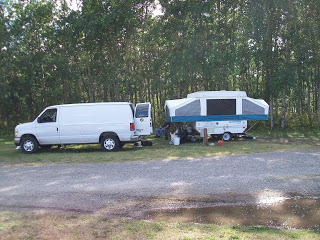 This year, we decided to vacation with a couple we’ve known for years and have become very good friends with. Vacations like this can either cement those friendships or destroy them. So far, I’m very deep into cement. A blown tire on the camper at 70 miles per hour, a short in the electrical system in the camper so that we had no power in a primitive camp site, a bad valve stem in a rear tire on the van…and we’re having the time of our lives.
This year, we decided to vacation with a couple we’ve known for years and have become very good friends with. Vacations like this can either cement those friendships or destroy them. So far, I’m very deep into cement. A blown tire on the camper at 70 miles per hour, a short in the electrical system in the camper so that we had no power in a primitive camp site, a bad valve stem in a rear tire on the van…and we’re having the time of our lives.
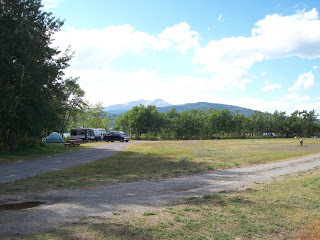 The scenery is amazing. The historical sites have made my trip so worth it for research purposes. I’ve seen wild animals on this trip I have never seen in the twenty five plus years I’ve traveled out west. Sitting out at night in the Badlands in South Dakota and watching the first stars wink into view, and then more, and more, and more until the whole night sky was filled with twinkling, glittering diamonds and to see the Milky Way stretching from horizon to horizon—I could have sat out with my head tilted back all night long.
The scenery is amazing. The historical sites have made my trip so worth it for research purposes. I’ve seen wild animals on this trip I have never seen in the twenty five plus years I’ve traveled out west. Sitting out at night in the Badlands in South Dakota and watching the first stars wink into view, and then more, and more, and more until the whole night sky was filled with twinkling, glittering diamonds and to see the Milky Way stretching from horizon to horizon—I could have sat out with my head tilted back all night long.

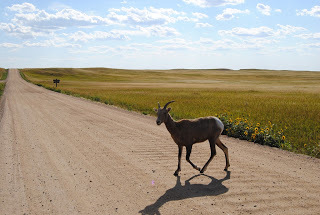
Because we have no real set itinerary, we stop when we want to, see what we want to, and as I said, we’re having the time of our lives. Tonight, we’re camping on the shores of St. Mary’s lake near Glacier National Park. Tomorrow, we’ll explore Glacier. And we may take a few days to do that. No set time table, no place we absolutely have to be…
 This year, we decided to vacation with a couple we’ve known for years and have become very good friends with. Vacations like this can either cement those friendships or destroy them. So far, I’m very deep into cement. A blown tire on the camper at 70 miles per hour, a short in the electrical system in the camper so that we had no power in a primitive camp site, a bad valve stem in a rear tire on the van…and we’re having the time of our lives.
This year, we decided to vacation with a couple we’ve known for years and have become very good friends with. Vacations like this can either cement those friendships or destroy them. So far, I’m very deep into cement. A blown tire on the camper at 70 miles per hour, a short in the electrical system in the camper so that we had no power in a primitive camp site, a bad valve stem in a rear tire on the van…and we’re having the time of our lives.  The scenery is amazing. The historical sites have made my trip so worth it for research purposes. I’ve seen wild animals on this trip I have never seen in the twenty five plus years I’ve traveled out west. Sitting out at night in the Badlands in South Dakota and watching the first stars wink into view, and then more, and more, and more until the whole night sky was filled with twinkling, glittering diamonds and to see the Milky Way stretching from horizon to horizon—I could have sat out with my head tilted back all night long.
The scenery is amazing. The historical sites have made my trip so worth it for research purposes. I’ve seen wild animals on this trip I have never seen in the twenty five plus years I’ve traveled out west. Sitting out at night in the Badlands in South Dakota and watching the first stars wink into view, and then more, and more, and more until the whole night sky was filled with twinkling, glittering diamonds and to see the Milky Way stretching from horizon to horizon—I could have sat out with my head tilted back all night long.

Because we have no real set itinerary, we stop when we want to, see what we want to, and as I said, we’re having the time of our lives. Tonight, we’re camping on the shores of St. Mary’s lake near Glacier National Park. Tomorrow, we’ll explore Glacier. And we may take a few days to do that. No set time table, no place we absolutely have to be…

Published on August 08, 2016 22:00



